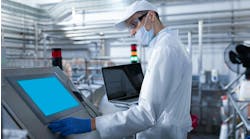Touching less, worrying less, doing more in the COVID/manufacturing era
Nymi's Chris Sullivan
During the recent Rockwell Automation Fair At Home, Nymi CEO Chris Sullivan presented on new solutions—particularly wearables—that are empowering workers as we approach 2021. We wanted to learn more, so we posed additional questions to Chris about his concept of touching less, worrying less and doing more. Take a look…
Smart Industry: Let’s start broadly…how are new solutions powering more efficient industrial environments?
Chris: New and innovative hands-free technology tools are supporting manufacturing efficiency by creating connected workers. Slowly, legacy and bespoke market solutions that were expensive, burdensome from an operational perspective, and lacked a simple user experience (UX) are being replaced with new solutions that allow workers to seamlessly move through their day so that they may touch less, worry less, and do more.
New connected-worker solutions are now addressing every workplace need in one easy-to-deploy-and-adopt solution—driving employee efficiency through a smarter UX while ensuring privacy by design principles and zero-trust security. For example, by deploying a workplace wearable with biometrics and cryptography, companies can continuously authenticate their workers without adding extra steps to their days. This also diminishes the negative impact on productivity with touchless authentication. Creating a complete connected-worker platform enables companies to build on their key digital-transformation goals.
Smart Industry: The pandemic has also spotlighted new workplace safety needs. How does technology help manufacturing companies keep their workers safe and healthy?
Chris: Industrial workers played a role in powering society through the pandemic—working on the frontlines to manufacture and ship products to meet growing consumer demands. The pandemic sparked a sense of urgency for manufacturing companies to identify new tools that kept their workers safe and allowed for business continuity. Even one COVID-positive worker in a plant could result in days or weeks of downtime to sanitize the facility and test all workers.
While many companies began by requiring self-health attestation checks, temperature checks, and additional PPE layers (including masks and gloves), they were also on the hunt for solutions that support social distancing and contact-tracing efforts in a seamless way, so as not to disrupt workers’ days.
Using the same type of connected-worker technologies, companies can balance physical access and productivity with managing the health and safety of workers. There are hands-free devices worn by employees that function under all newly required PPE layers. Once authenticated, these wearables can sense proximity to other devices; if another device is too close, it can warn users that they may be at an unsafe distance through a vibration or alert. Taking this process a step further, these same sensing tools can capture proximity insights for contact-tracing analytics, ensuring that anyone that had been in relative close contact to a COVID-positive worker would be promptly alerted.
Smart Industry: So the pandemic has accelerated industrial innovation?
Chris: Absolutely. The pandemic has forced every industry to think more strategically about operations and the technologies they deploy. Efficiency, safety and security have always been top priorities, but COVID-19 has pushed the stakes higher. Business continuity now relies on accomplishing all three. Over the past six months, we’ve seen a list of new solutions enter the market, most of which focus on solving one pressing issue facing manufacturing companies and their workforce—social distancing and contact tracing or self-health attestation apps, for example.
However, businesses can’t rely on the same old piecemeal strategies. The key is to invest in connected-worker solutions that are strategic and scalable for the challenges you can't account for today. For example, in our session at the Rockwell Automation Fair At Home we discussed the value of proximity sensing for social distancing and contact-tracing applications. Beyond the pandemic, this same technology can be easily applied to broader safety applications such as monitoring proximity to certain dangers, like heavy machinery or moving vehicles. This is really important because workplace efficiency and safety will continue to be priorities post-pandemic, and it’s crucial that technologies are flexible enough to respond to new challenges.
Smart Industry: What is the top trend for industrial workplaces as we move into 2021?
Chris: 2020 forced industrial businesses to rethink their digital initiatives. While many had begun chipping away at digital-transformation goals, the pandemic flipped everything upside down.
Moving into 2021, companies may have access to a COVID-19 or pandemic budget along with a much clearer vision for driving smarter DX strategies forward to improve efficiency, safety and security. The big trend will be a shift away from deploying separate and bespoke point solutions that don’t interconnect with one another and therefore, add unnecessary burdens to the entire organization.
In the coming year, manufacturers will take their lessons learned from the pandemic and invest in scalable systems that offer comprehensive capabilities to support connected workers of today, while driving new business value for tomorrow.




